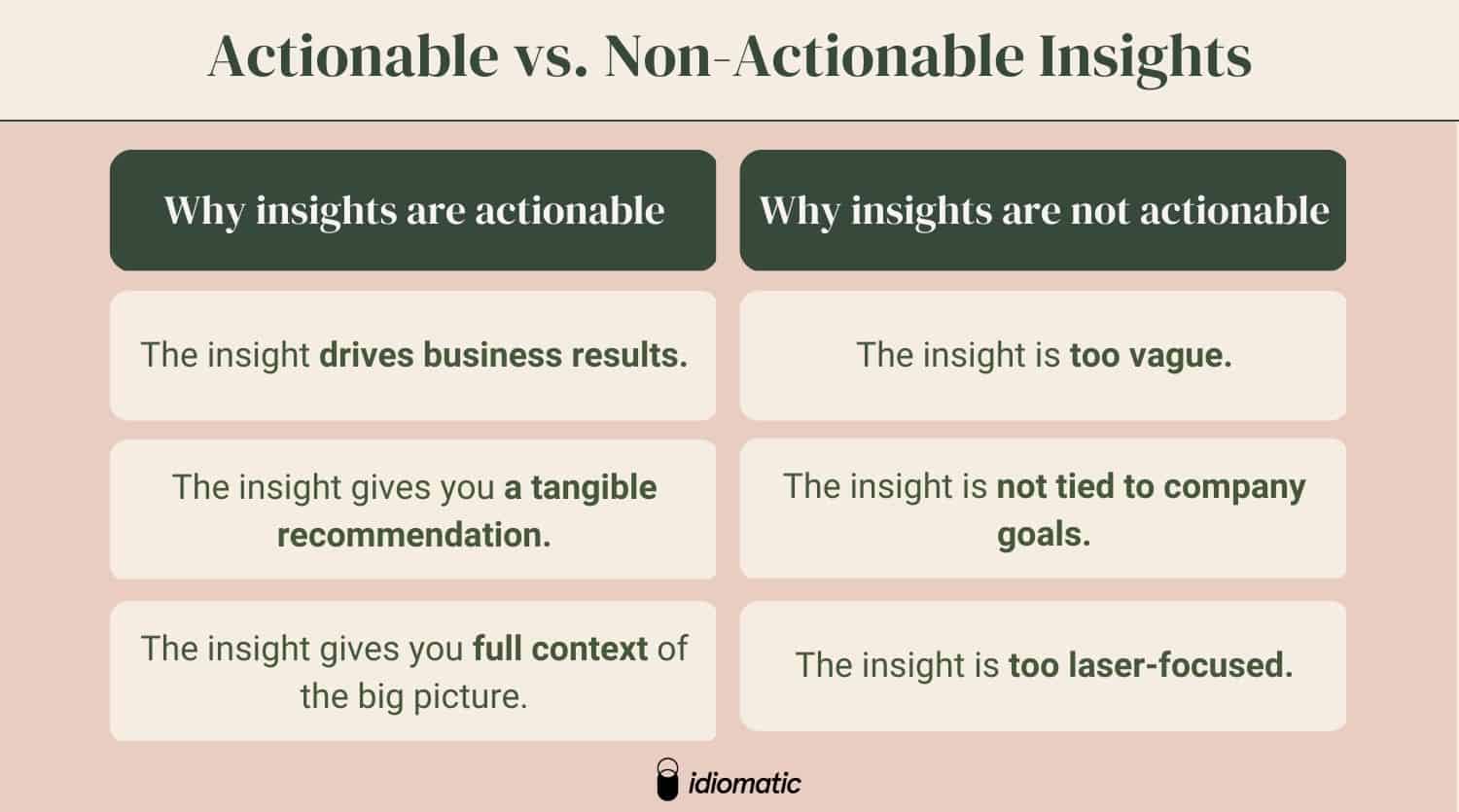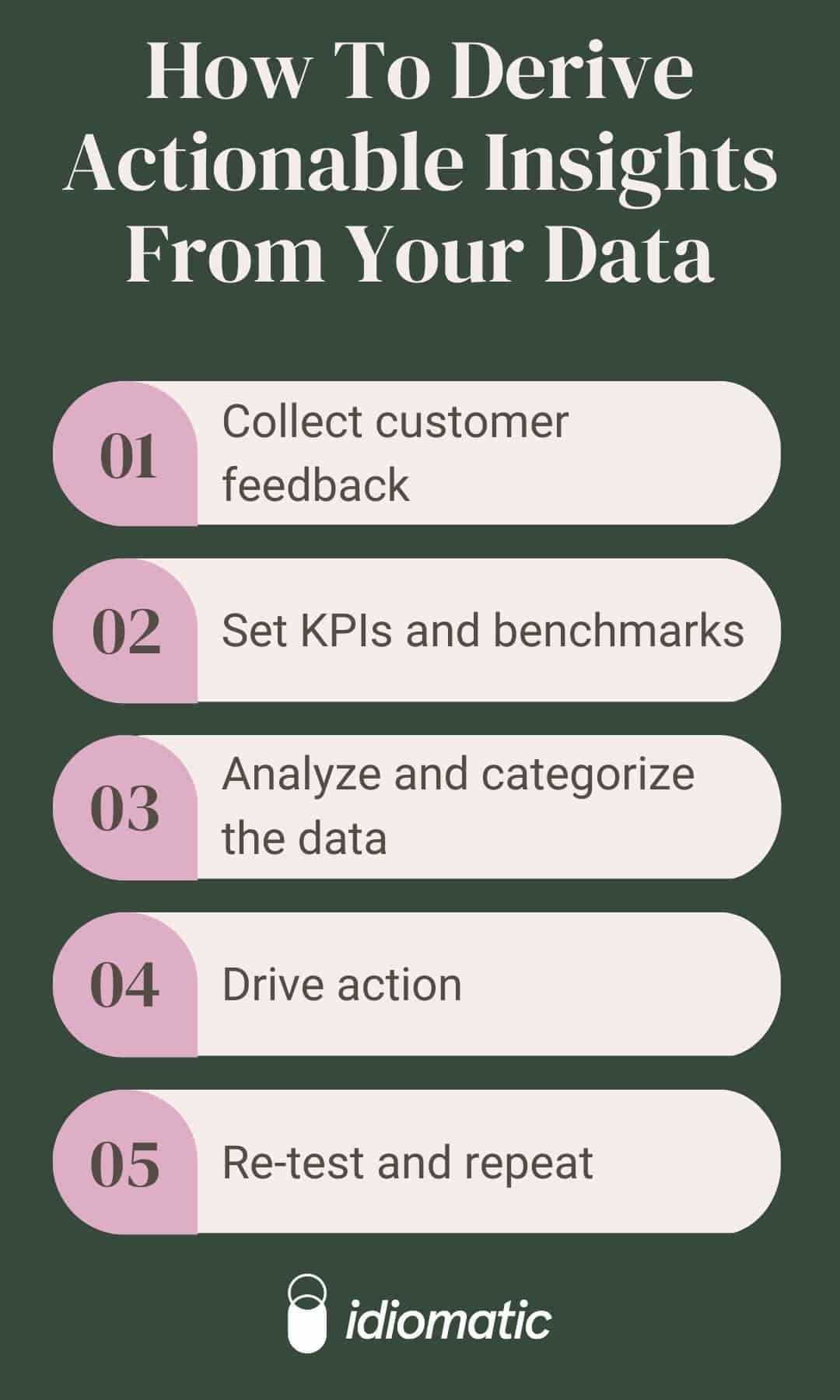Finding actionable insights in your raw business data is essential to drawing data-driven business conclusions in your customer’s best interest and yours. Actionable insights help you make sense of your raw customer data and connect commonalities in data values to real-life actions.
These insights can be generated from many data sources and will help inform business decisions to meet your business goals and increase customer satisfaction.
In this article, we’ll discuss the topic of actionable insights and how you can unlock them to maximize business growth.
Contents
What are actionable insights?
Actionable insights are business conclusions derived from your raw data. They can be used to directly inform business decisions to improve and optimize your customer’s experience. They’re the best business decisions you can make because they’re data-informed.
These data-informed insights aren’t generated directly from raw data. First, data needs to be collected. Then, it must be categorized and analyzed before the actionable insights can be determined.
Here is the distinction between three stages of developing actionable insights:
- Data: Individual pieces of information, potentially including feedback forms, customer service interactions, app or account usage data, and social media conversations.
- Analytics: Sorting of qualitative and quantitative data into meaningful groups and categories.
- Insights: Contextualizing your data to look for commonalities, correlations, and trends to develop data-informed predictions of future actions and customer sentiment.
Machine learning algorithms can be used to make data analytics and insights faster and more efficient than manual reviewing. Using a platform like Idiomatic, you remove any human errors in manual tagging and interpretation, and get real-time results so you can act on the insights quickly to increase customer satisfaction.
Actionable vs non-actionable insights
With so much data available to your business, it’s important to recognize actionable insights that drive business results from non-actionable or non-insightful results.
Non-actionable insights are results that are vague, impractical, or not tied to a specific goal.
Actionable insights include results you were not expecting or that confirm a hypothesis. They provide deeper, data-driven insights to support a business decision or change. Actionable insights lead to action and change or confirm that no change is required.

Why some insights are not actionable
There are three key reasons your data insights may not be actionable:
1. Your insight is too vague: Even if you collect lots of qualitative and quantitative data, it doesn’t always mean you have the right data for drawing conclusions that’ll provide actionable insights. For example, you may know that customers are dissatisfied with the login process, but that doesn’t give you enough data to understand what needs to be changed. To find the missing link, you need to do more research to uncover the exact part of the login process causing customer pain so you know what to address.
You could do this additional research manually or use a customer feedback analytics tool to do this for you. Idiomatic can pull these deeper insights from your customer data in real time, so you don’t have to waste time and money to get the additional context you need.
2. Too laser-focused: Sometimes you may have some great data, but it may not lead to an actionable insight if you’re not analyzing it with your big-picture business in mind. For example, your analytics might tell you that there has been a 23% increase in customers complaining about missing password reset emails in the past month. But unless you compare this result to results from other customer complaint categories, you may miss that 40% of all customers complain that your recent font color change in your mobile app makes it hard to read. Look at all insights in context from a higher-level view of your business as a whole. Combined with more focused analysis, this can allow you to determine which actionable insights are more important than others.
3. Not tied to company goals: Insights are great, but if they’re not tied to company goals and strategic priorities, making changes to improve the customer outcome may not be the best use of your resources. For example, you may have uncovered an excellent, specific insight and have the full context of the big picture. But if your insight is tied to efficiency when all your CEO cares about is growth, it’s still not actionable.
Actionable insights examples
Actionable insights give you tangible recommendations. Your analytics may say that customers are dissatisfied with your product, but actionable insights tell you why so you can identify the change needed.
Here are some examples of actionable insights you might get from your data analysis:
- Identifying ideal placement for cross-selling opportunities
- Creating marketing campaigns that address real customer needs
- Increasing customer access to real-time customer support channels
- Restocking products after seeing people adding an out-of-stock item to their digital wish list
Why do actionable insights matter?
Actionable insights drive business outcomes. They provide the statistical backing to support decisions regarding business change and with the ultimate goal of increasing customer satisfaction, increasing revenue, or growing your company.
Collecting customer feedback and using machine learning to derive actionable insights can help you measure the effectiveness of any changes you make in your business, such as a new marketing campaign or product feature, or to measure overall customer satisfaction.
Where can I find actionable insights?
You can use business/customer intelligence tools to analyze the data sources below, gather relevant data and find actionable insights. Ideal data sources include:
- Customer Support: Data generated from customer support conversations and interactions.
- Customer Surveys: These include NPS surveys, CSAT scores, CES, and feedback surveys that gather customer opinion and satisfaction scores.
- App Reviews: Information captured during app ratings and reviews.
- Social Media: Monitor what people say about your brand and offerings on social media.
- Forums and Communities: Follow conversations to learn more about how customers are using, or struggling with, your offerings.
- Product Reviews: Using data from product ratings and comments to better understand customer pain points.
Having the data from as many of these external sources as possible is step 1. Then, analyze the data to look for high-volume issues or those that create a negative sentiment to inform your actions.
Step-by-step: Deriving actionable insights from your data
When your organization is ready to make better use of data analytics and big data for making decisions in the business, here are the steps to generate the actionable insights to move your company forward:

Step 1: Collect customer feedback
Start with all data sources you currently have for customer feedback. These may include social media listening tools, customer exit surveys, and NPS surveys. Gather this data in one central platform and set up an API to link third-party tools with your business intelligence tool, so they update in real time as you collect more data. Start collecting other sources of customer-supplied feedback to fill any gaps in the customer journey or experience as they relate to your business goals.
Step 2: Set Key Performance Indicators (KPIs) and benchmarks
Is a 15% increase good or bad? How does your customer support ticket resolution time stack up against the competition? These types of measurable KPIs and benchmarks will allow you to decide whether an insight is worth taking action on or not.
Step 3: Analyze and categorize the data
Next, use an AI tool like Idiomatic to do the heavy lifting of categorizing and quantifying all your raw feedback data, including qualitative data. Idiomatic’s machine learning model does the processing of the data and gives you real-time, analyst-quality insights without you doing the manual work. Once processed, you’ll be able to see the categories and issues derived from your data which will guide you to generate actionable insights.
Step 4: Drive action
Based on your newly generated insights, take action to improve customer satisfaction and CSAT survey scores by addressing customer concerns or struggles. This insight may include something as “simple” as a software bug fix or more in-depth, like redesigning an entire marketing campaign or product to meet customer needs better.
If your data reports no changes needed, the business aspect you are analyzing is likely currently optimized. No action is necessary at this point, but continue monitoring it for any changes.
Step 5: Re-test and repeat
When you’ve made a business change, give that change time to ripple down to your customers and then analyze the data again to see if the insights indicate progress or resolution has been made. If not, act on any new actionable insights and repeat them until you get a satisfactory result.
Using machine learning to derive actionable insights
Actionable insights are much easier and faster to generate, and more reliable when you use a machine-learning platform to collect, organize, analyze, and generate actionable insights for your business. Idiomatic’s customer insight software helps you unlock the “why” behind customer feedback by going beyond simple Natural Language Processing (NLP) analysis. Idiomatic uses sophisticated, contextual machine learning techniques to give you real time, actionable insights that can drive action to improve CX.
Idiomatic gives you human-quality insights at scale, so as your business grows, you can continually process large volumes of data without human errors, which are common in manual analysis.
Request a demo today to see how Idiomatic can help you take mountains of raw data, analyze it, and provide you with easily understandable, data-backed actionable insights.




